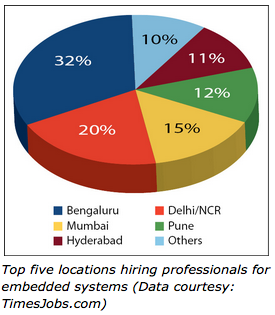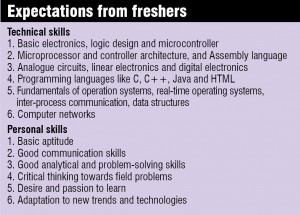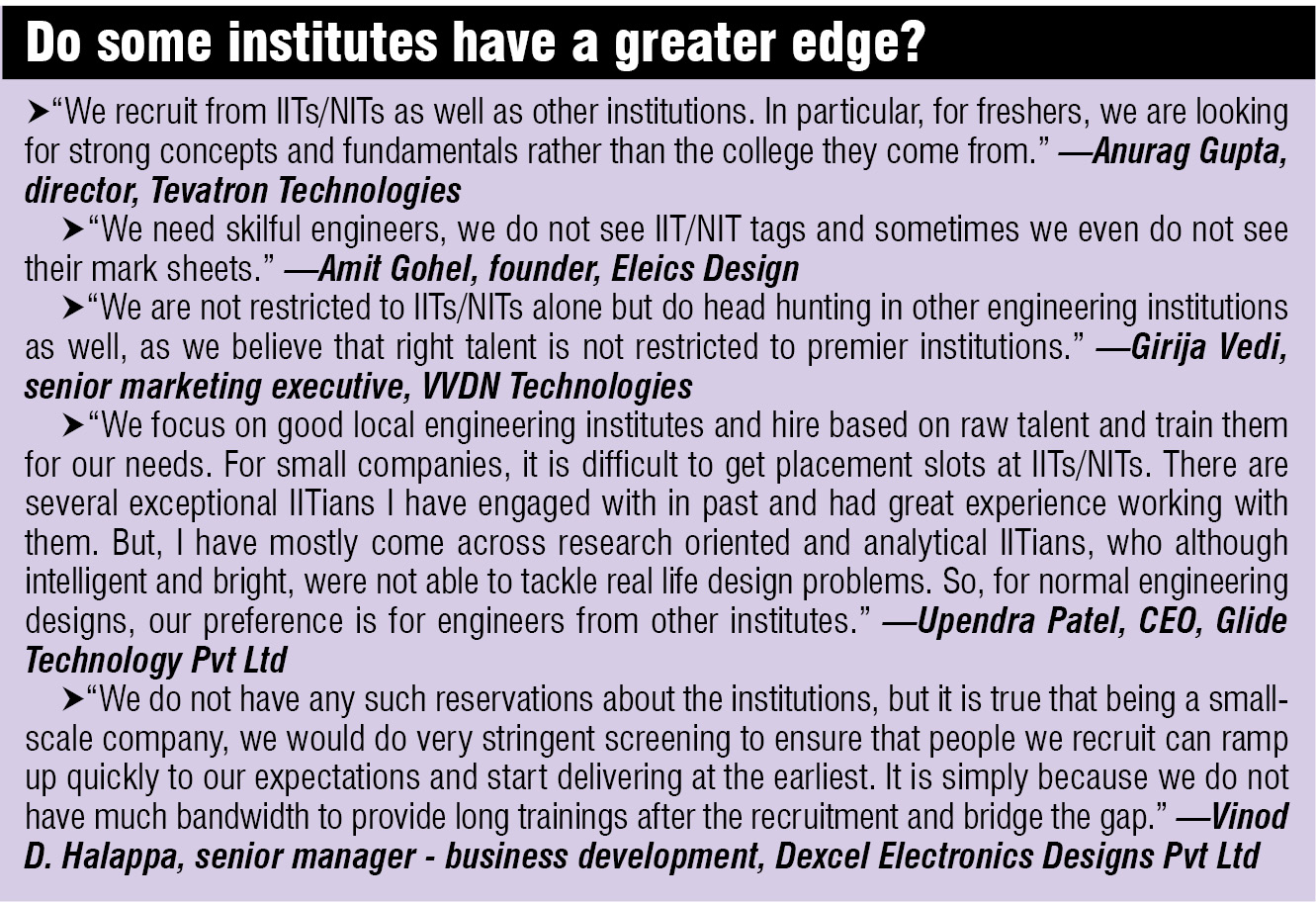Embedded systems are popular in healthcare, consumer goods, video security/surveillance, information technology (IT), telecommunication, Internet of Things (IoT), automotive and manufacturing industries, and now in the upcoming wearable electronics sector. With such pronounced existence, let us find out what a career in this field has to offer.
information technology (IT), telecommunication, Internet of Things (IoT), automotive and manufacturing industries, and now in the upcoming wearable electronics sector. With such pronounced existence, let us find out what a career in this field has to offer.
“Embedded design and development industry is so vast that it will consistently need core talented engineers with good hardware and software knowledge and, most importantly, out-of-the-box problem-solving skills,” according to Amit Gohel, founder, Eleics Design.
Most electronics graduates are unaware of the abundant opportunities available in the field of embedded industry, believes Sakthivel K., chief executive officer, Caliber Embedded Technologies India (P) Ltd. He says, “According to the NASSCOM report, the total embedded system global business is expected to reach around $90 billion by 2015, wherein India alone is expected to have a share of around $16 billion.”
On a similar note, Girija Vedi, senior marketing executive, VVDN Technologies also believes that career in the embedded domain is a worthy option available for electronics engineers today. She says, “As VVDN specialises in developing embedded systems for various segments, we are likely to hire around 500 engineers by 2014 year end, but shortage of candidates with the right talent is definitely one of the hurdles we are facing in achieving our goal.”
Hardware design or software testing option
Fresh electronics engineers having good knowledge and interest in digital and analogue electronics circuit design could choose board design as their field, advises Vinod D. Halappa, senior manager – business development, Dexcel Electronics Designs Pvt Ltd. He says, “With additional knowledge of VLSI/FPGA technology, design flow and HDL/System C, they can also get into ASIC/FPGA design/verification field.” Fresh computer engineers with good basics of computer architecture, microprocessor/controller-based system design, embedded C, Linux (or any embedded OS) can go for embedded software as their field. He adds, “There are ample jobs in embedded software testing as well, for which they would need some specific training in state-of-the-art testing tools, methodologies and scripting languages for about three to six months.”
electronics circuit design could choose board design as their field, advises Vinod D. Halappa, senior manager – business development, Dexcel Electronics Designs Pvt Ltd. He says, “With additional knowledge of VLSI/FPGA technology, design flow and HDL/System C, they can also get into ASIC/FPGA design/verification field.” Fresh computer engineers with good basics of computer architecture, microprocessor/controller-based system design, embedded C, Linux (or any embedded OS) can go for embedded software as their field. He adds, “There are ample jobs in embedded software testing as well, for which they would need some specific training in state-of-the-art testing tools, methodologies and scripting languages for about three to six months.”
With the recent initiatives of the government of India to promote local electronics system design and manufacturing (ESDM), announcements to setup new semiconductor fabrications units and incentives to units being set up in various electronics clusters, local electronics manufacturing in India is poised for a major growth. Rajeev Tiwari, director, Tevatron Technologies says, “With this renewed emphasis on ESDM, engineers with skills in embedded systems, device drivers, firmware, hardware-software integration, PCB design, board design, graphics driver and real-time operating system would be most sought-after. At the same time, at product level, since a lot of innovation will start taking place in local market, product marketing engineers and managers will also get lot of attention.”
With the rapid growth of electronics and consumer markets, plenty of smart devices are getting released within a short span of time. Undoubtedly, there is a shining future ahead for fresh candidates as well, informs Paramita Kapat, head – human resource, eInfochips. She says, “Compact embedded devices are playing a major role in the boom of various industries, especially smartphones, tablets and medical equipments. In nutshell, embedded systems field is the most diversified for electronics as well as computer science students.”
Also, with the advancements in electronics, embedded systems field is becoming a niche segment and there is an influx of new products in market. Upendra Patel, CEO, Glide Technology Pvt Ltd says, “This is driving demand for both outsourcing projects as well as domestic products. Due to this, there is good demand for engineers in embedded systems industry.” Although, he thinks, there is shortage of qualified and experienced resources.
Embedded systems industry offers great amount of career opportunities in various fields that are connected with product life-cycle and typical system architectures of current embedded products, informs Halappa. Basic requirement for a career aspirant in this filed would be having specialisation in electronics, computers or any other related engineering. He says, “If we have to rank various fields by the number of opportunities generated by them, the list would be topped by embedded software design (~73%), followed by ASIC design (~15%), FPGA design (~4%), board design (~4%), CAD design (~2%), production services (1%) and sales and marketing (~1%).”
How freshers are placed
To design even a simple product, one has to study and know so many parameters and design requirements, which cannot be achieved without experience and cannot be taught at college, opines Gohel. He says, “Generally fresher engineers are considered to be ‘too early’ for embedded product design. So, for the initial few months, we put them under testing and validation of designs, and after they gather some experience, we let them develop customer applications under the supervision of senior engineers.” “The semiconductor industry always comes up with new and improved components, so one has to keep updating with new technologies used and market’s needs. This industry is only for the passionate people, and hence one cannot survive if s/he is not abreast with the latest happenings,” he adds.

On the positive side, there is a good scope for fresh engineering talent in the industry, provided they meet the basic industry standards, informs Vedi. VVDN’s selection process consists of basic-level (C/C++, electronics, aptitude) written entrance exam followed by an interview. She says, “Entry-level role is normally that of a trainee. They are on probation for three months. Students need not go to specialised training centres after their graduation.” She adds, “As a trainee, candidates get an opportunity to get involved in various roles, which include hardware development, software development and testing. Based upon the candidates’ interest and performance during the probation, trainees are accredited as full-time employees and are given specialised designations based on their interest and company’s requirement.”
Talking about eInfochips, Kapat informs, “In product design projects, we prefer candidates to start as application engineers and then gradually, when they understand the product, they can dig into lower layers. Candidates who have good knowledge of programming languages and operating systems can directly start as firmware engineer where they get opportunity to learn about different systems on chips (SoCs).” She adds, “We also have well-defined on-the-job training programmes where a fresh candidate not only learns project-specific things but is assigned responsibilities to perform tasks.”
Typical training period
Patel shares that it is very difficult to get experienced personnel, and the only way is to hire fresh engineering graduates and train them for the required technologies. He says, “As colleges are lacking qualified lecturers and infrastructure to cope up with new technology development, fresh engineers should start with a few months of training on basics and devices/technologies used in current products. Once they spend about three to four months, they can be used as design engineers or firmware engineers under the supervision and guidance of senior engineers.” He adds, “Even at entry level, they can prepare schematics, small board layouts and write application software modules.”
Typically, entry-level engineers would be trainee engineers for three to six months, during which they get exposed to the company’s work culture, product design life-cycle, design flow and methodology, standards/guidelines for design, coding, testing and safety, and quality compliance and IP protection policies. Halappa says, “After their tenure as trainee, based on individuals’ performance in their earlier project tasks and their background experience, they would be assigned module-level design and/or testing tasks. But the kind of work and exposure that an individual gets may very well depend on the dynamics of ongoing projects and also individual’s ability to grow with the challenges.” He adds, “Typically, fresh engineers would mature as full-fledged design engineers in a span of three to five years, depending on their focus and ability.”
Higher demand for software engineers
“With the rise of the Internet of Things, embedded systems have received a huge push forward and their complexity has led to a great demand for skilled professionals and technologists in this field. The majority of the roles are focussed in the IT software sector with Bengaluru, Delhi and Mumbai serving as the main hubs for companies engaged in employing these high-end programming skills. As with all niche specialisations, entry-level salaries quickly rise as the professional gains valuable on-the-job experience and deals with real-world scenarios,” explains Vivek Madhukar, COO, Times Business Solutions Limited.
Apart from Bengaluru that features in the list of top locations for jobs in embedded field with 32%, figures indicate Delhi, Mumbai and Pune share 20%, 15% and 12% of the jobs, respectively. Remaining jobs are scattered in other locations.
Low pay initially
Talking about Tevatron, Anurag Gupta, director, Tevatron Technologies informs, “We recruit experienced and fresh engineers for embedded systems, firmware, VLSI design and chip design. The package varies from candidate to candidate, ranging from 300,000 to 2,000,000 rupees per annum, based on their experience level.”
At Eleics Design, fresh graduates spend their initial months in training and learning, and hence they offer them a package of 100,000 rupees per annum. Solely based on their performance, pay is gradually incremented, informs Gohel. Talking about experienced professionals in embedded design, he says, “They will get a pay package of around 200,000 to 320,000 rupees per annum and, again based on performance, s/he will receive increments and other perks.” He adds, “In some cases, we also pay on hourly basis to experts, and that amount varies as per his/her design specific expertise.”
Vedi informs, “VVDN Technologies hires B. Tech/B.E. graduates from electronics, computer science, IT and electrical branches. For freshers, an approximate pay of 240,000 rupees is provided whereas for experienced professionals, it depends on their experience and knowledge.”
At Caliber Embedded Technologies, Sakthivel says, “For fresh graduates we are offering between 125,000 and 175,000 rupees per annum and for experienced professionals we are offering 250,000 to 350,000 rupees per annum, based on the level of experience of the candidate.”
On behalf of eInfochips, Kapat too affirms that they hire fresh engineers from engineering institutes all across the country. She says, “Depending on their qualification and institute, salary can be in the range of 200,000 to 300,000 rupees per annum.”
At Glide Technology, Patel informs, “We have a mix of senior persons with freshers. Freshers’ salaries range from 120,000 to 180,000 rupees and largely depend on the institution they had studied at and their college project. For experienced professionals, it is based on past experience, and there are no fixed criteria. We even hire freelance professionals with specialised skills on hourly rates for specific jobs.”
Skills expectation
The industry expects basic knowledge and skills from the freshers but specific skills from the experienced. For the skills expected from a fresher, see the box titled ‘Expectations from freshers,’ which is based on views of the industry experts.
The skills expected from experienced candidates are much more specific, apart from the basics and soft skills of course. Tiwari says, “They should be equally conversant with hardware and software, particularly analogue IC, components and the digital counterparts, interfacing of I/O peripherals to microcontroller and building the embedded core programming logic from scratch.” He adds, “They should be aware of the latest developments and emerging technologies like 32-bit ARM processor, Raspberry Pi, Arduino, Embedded Linux, RTOS and interfacing Android apps to embedded hardware.”
Speaking more specifically, Gohel says, “S/he must have worked on at least three MCU platforms such as Microchip PIC16/PIC18/PIC32,TI MSP430, Renesas RX62N and Atmel ATMega32 to list a few, and must be good at electronics and software development. S/he should have stabilised at least two or more products in the past and should also have a flair for PCB designing.”
But when it comes to the experienced graduates, they are expected to carry product engineering/development knowledge for some specific domains like the consumer, defence, industrial automation, semiconductor, avionics or bio-medical sector, informs Halappa. He says, “In general, they must be strong in design aspects and considerations to meet the requirements for a product in a given domain in terms of performance, cost, quality and standard compliance. Specially quality and process compliance would be of great importance when it comes to defence, avionics and bio-medical products.”
Experts’ advice
Embedded systems, being so omnipresent and so inevitably embedded into our modern lifestyle, could be the single largest enabler that would play a significant and ever-growing role in shaping our future tools, gadgets, machines and equipments in the fields ranging from agriculture to automotives, infotainment to health, processing to construction industry and toys to aircrafts. Halappa says, “I would encourage fresh/experienced engineers to consider this field as one of the top options as it offers highly challenging, learning and rewarding career for engineers with enthusiasm to be part of this futuristic industry.”

“Mobile devices are driving the electronics development. Hence, the designs are miniaturised and have several challenges to be addressed. The engineers need to strengthen their knowledge on currently used devices, which are not taught in colleges, on their own by studying and experimenting with kits available in market,” informs Patel. Halappa advises, “There are lot of low-cost development kits available in market to play with new processors and software architectures. Most of them share schematics, design files and firmware on the Internet, which can be a good way to learn embedded system design aspects to get entry in organisations.”
Patel says, “There is lack of good-quality staff and infrastructure in many colleges. Knowledge of faculty in current technologies is also very limited. Therefore our advice to people looking for career in embedded systems will be to attend short-term courses in embedded systems or take an entry-level position in an organisation that specialises in embedded product design at low salary instead of taking up QA/testing/application development job at higher salary in traditional IT companies.” On a similar note, Tiwari says, “Students need to invest their time in learning hands-on practical skills and concepts which are currently in demand. They should try to become industry-ready and only then they can get a job of choice in this market.”
“Candidates need to develop right skills and attitude. Apart from the technical knowledge and consistent academic performance, companies are in need of people having passion towards technology, who keep them abreast with the latest advancements in the technology, who take initiatives in their field and add value to their work,” opines Vedi.
Can engineering institutes be blamed?
Nowadays, you get to hear quite often that engineering graduates are raw and unemployable. The blame, conveniently, is transferred to the institutions and the government, feels Vedi. She says, “I admit that it is the onus of the institutions and government to bring a change in the course curriculum and give an ideal environment to young students where they can learn and adopt necessary skills helpful for them to be employed in the industry.” However, she adds, “I feel that students should take initiative and get involved in proactive measures to learn and develop skills which would help them in the long run. Internet and social media, groups and communities have made the information accessible to them in just one click. They should spend their time on enhancing their knowledge plus also work on improving their communication skills. After all, what companies require from a fresh graduate is just the basics plus good communication and, above all, right attitude.”
Halappa agrees that the industry often complains that fresh graduates, coming out of regular institutions, are not ready for the industry. “It does not mean that the curriculum in these institutions is inferior, but in fact it is somewhat over-ambitious and looks like super popular packages of all the latest technologies tailored to please every company that is coming for campus recruitment. So the real need is to ensure that the engineering colleges concentrate more on teaching better basics and providing practical orientation to contemporary subjects than dealing with every advanced and research area,” he says.
Halappa believes that subjects need to be dealt in top-down approach rather than bottom-up approach. He cites, “The top-down approach would first give overall perspective of the subject, even before getting into the details of it. Unfortunately, the current and more prevalent bottom-up approach allows students to learn bits and pieces of the subject that may be easier to learn and score even without getting the overall perspective of the subject.”
For this change to happen, Halappa feels the text books should be written with top-down approach. The teaching fraternity in the engineering institutions, who are the key players in this eco system, should be allowed, encouraged and even compelled to interact with industries on regular basis and gain insight to the product design life-cycle, design methodologies, standards and compliance, and the kind of job profiles available to engineers in the industry. “Only when a comprehensive system for training the trainer is established by the responsible and committed involvement of both industry and institutions, this gap can be minimised,” according to Halappa.
The author is a senior technical correspondent at EFY






